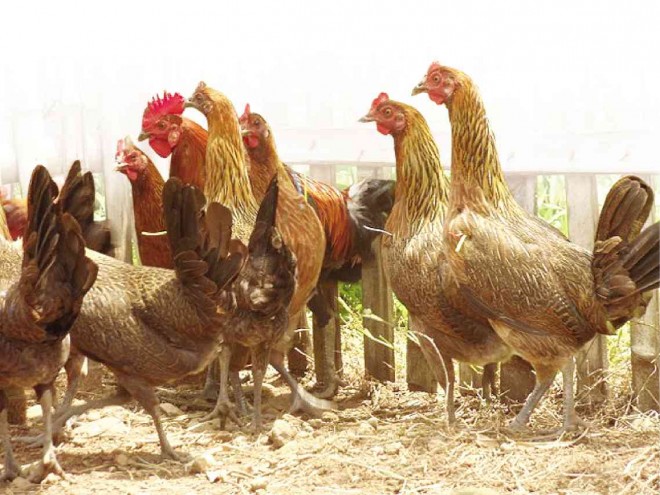Raising ‘darag’ chickens from backyards to farms

EVOLVED from the red jungle fowl, “darag” is indigenous to Western Visayas and is a favorite of locals savoring the meat for its firm texture and distinct, almost gamey, flavor best for traditional Filipino dishes. CONTRIBUTED PHOTO
ILOILO CITY—Health-conscious Filipinos looking for ways to avoid food that clog the arteries have found a new entrée on their special menu of lean, protein-packed meat: darag native chicken.
Evolved from the red jungle fowl (Gallus gallus bankiva), the darag is indigenous to the Western Visayas region and is a favorite among locals due to its savory and firm yet distinct meat. Its almost gamey flavor is best for traditional Filipino dishes, like chicken tinola, inasal, tinuom, binakol and the internationally famous adobo.
Standing out from its bland, commercially grown cousins, the fowl has a flavorful meat attributed to unused free amino acids and muscle exercise that it gets while being raised under the “grass range system.”
As of December 2014, more than 7,000 breeders had been nurtured in 70 farms in the region.
West Visayas State University (WVSU) started its research studies on darag in 1985, gaining much support later from the Philippine Council for Agriculture, Aquatic and Natural Resources Research and Development (Pcaarrd).
Article continues after this advertisementIn 1999, researchers Bernabe Cocjin and Angel Lambio tested the feasibility of adopting, with some modifications, the day-old chicks production system that the commercial industry was using against their own “hardening” of darag chicks for 45 days before distributing them to small-hold native chicken growers who did not have or could not afford artificial brooding facilities and vaccination.
Article continues after this advertisement100% production rise
In 2008, the Pcaarrd reported that with documentation and studies, the technologies of breaking broodiness in native chicken, as well as artificial incubation and brooding were found to double egg and day-old chick production.
The agency funded another study, “Sustainable Darag Native Chicken Production in Western Visayas,” that involved a consortium of universities, with WVSU as lead agency and three other cooperating schools—Aklan State University, Capiz State University and Central Philippine University.
The consortium offers a package of technologies (POTS) to entrepreneurs.
Darag chickens are bred and hatched in the WVSU-Project 1 Nucleus Breeder Farm, a
100-hen hatchery station maintained by WVSU to produce quality darag chickens for breeding and distribution to three other hatchery stations located in the Calinog campus of the other universities.
The farm also aims to produce uniform chicks in volume as source of stocks for commercialization. The business strategies adopted involved the putting up of the darag office that follows a set of qualifying criteria for development partners.
A letter of intent from the partners paves the way for the evaluation of the farm site, measuring at least 5,000 square meters and having adequate natural vegetation and poultry facilities, such as brooder, incubation and hatchery units, hardening and growing unit, and a breeding house with ranging area.
The entrepreneur must know the intricacies of poultry raising and is willing to join in data collection and documentation of the project. Start-up capital is P50,000.
Success factors
In the 2014 study, “Toward Commercialization of Darag Chicken Production,” researchers found certain factors that could contribute to business success. These are availing oneself of the POTS and access to information, plus training support, capital/investment, dedication to project, and good and efficient management.
Project 1 under the third program of Pcaarrd aimed to produce 7,000 breeders and 100,000 chickens for slaughter from Aug. 11, 2011 to Dec. 31, 2014. With prices of P250 per breeder and P180 per slaughtered chicken, Western Visayas can expect to earn P19.75 million within three years.
If more partners go into full commercialization after two years and produce a total of 500,000 chickens for slaughter yearly, income will reach P90 million, said a brochure produced by the university consortium.
Many farmers who are used to the ways of breeding nonnative chickens commercially have yet to be convinced of the viability of the darag. Thus, Pcaarrd came up with the annual Fiesta Event, or Farming and Industries Encounters through the Science and Technology Agenda.
The event seeks to provide a venue for industry players to discuss business opportunities and strategically position darag along with the best-priced quality chicken meat preferred by Asian neighbors, like Korea.
Once only a staple of rural households, the darag has indeed come a long way from just scratching in the backyards of farmers.